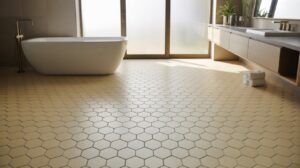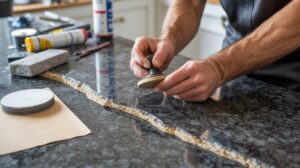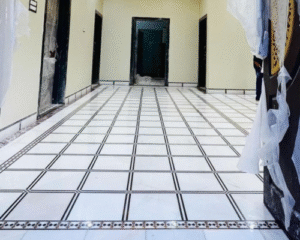Travertine Floor Cleaning: A Comprehensive Guide by SF Marble And Granite Inc.
Travertine Floor Cleaning is not just a chore; it’s a key aspect of preserving the timeless beauty and durability of your stone surfaces. Whether you have travertine floors in your home or commercial space, proper cleaning is essential to keep them looking pristine and well-maintained. In this guide, we will explore the ins and outs of travertine floor cleaning, sharing valuable insights to help you achieve immaculate surfaces that exude elegance.
Travertine floors are a beautiful addition to any home or space, but they require proper care to maintain their elegance. In this article, we will guide you through the essential steps of travertine floor cleaning, ensuring your floors remain a testament to luxury and sophistication.
Table of Contents
ToggleIf you’re looking to restore the natural beauty of your travertine floors, look no further than SF Marble And Granite Inc. Our expertise in Travertine Floor Cleaning ensures that your floors regain their pristine appearance, making your space shine with elegance and sophistication.
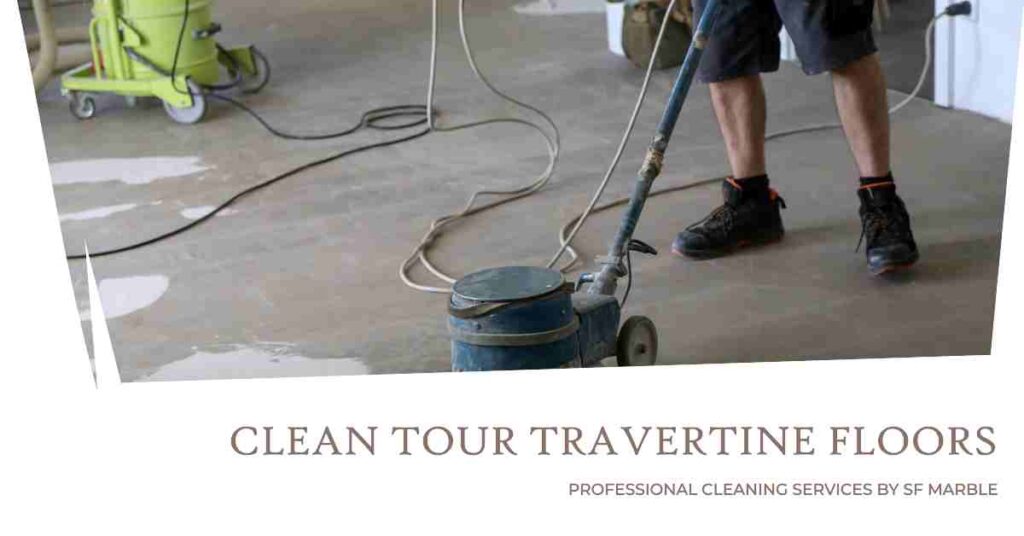
How Often to Clean Your Travertine Floors
Cleaning travertine floors is essential to maintain their beauty and longevity. The frequency of cleaning depends on various factors, including the level of foot traffic and the potential for spills and stains. Here’s a guide on how often to clean your travertine floors:
Daily Maintenance:
- Sweep or dust mop your travertine floors daily. This helps remove loose dirt, dust, and debris that can scratch the surface over time.
- Use a soft-bristle broom or a microfiber dust mop for this task.
- Consider placing doormats at entry points to minimize the amount of dirt brought indoors.
Regular Wiping:
- For routine cleaning, you should wipe down your travertine floors at least once a week or as needed.
- Utilize a mild dish soap diluted in warm water or a stone cleaner with a pH neutral formula.
- Dampen a soft cloth or mop with the cleaning solution, ensuring it’s not excessively wet.
- Wipe the floor in a circular motion, paying extra attention to high-traffic areas and spots where spills may occur.
Monthly Deep Cleaning:
- Once a month, perform a more thorough cleaning of your travertine floors.
- Use a specialized stone cleaner designed for travertine surfaces.
- As directed by the manufacturer, dilute the cleanser.
- Mop the floor with the diluted cleaner, ensuring it doesn’t leave streaks or residue.
- Focus on grout lines and any stains or spills during this deep cleaning.
Spill Cleanup:
- To avoid stains, spills should be cleaned up right away.
- Blot the spilled liquid with a soft, absorbent cloth or paper towel.
- Avoid wiping, as this can spread the spill. Instead, press down gently to absorb it.
- Clean the area with a damp cloth and a bit of stone cleaner.
Avoid Harsh Chemicals:
- Never use acidic or abrasive cleaners on travertine floors, as they can damage the stone.
- Avoid vinegar, ammonia, and bleach-based products.
Regular Sealing:
- To protect your travertine floors from stains and moisture, it’s essential to have them sealed.
- The frequency of sealing depends on factors like foot traffic and the quality of the sealer used. Generally, resealing is needed every 1-2 years.
By following these cleaning guidelines, you can ensure that your travertine floors remain in excellent condition and continue to enhance the beauty of your space. Regular maintenance will extend their lifespan and keep them looking their best for years to come.
Step-by-Step Cleaning Instructions
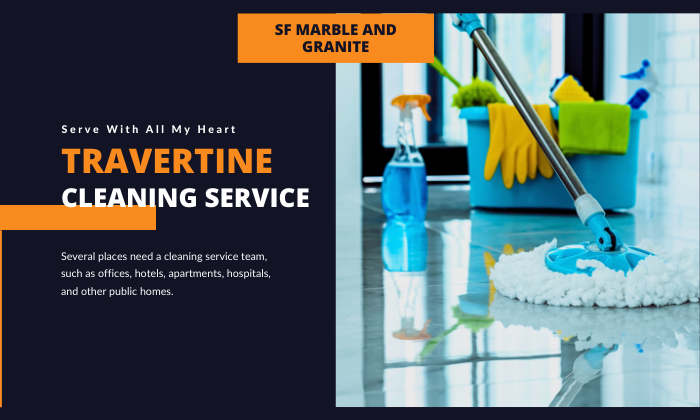
Cleaning your travertine floors properly involves a systematic approach. Follow these step-by-step cleaning instructions to ensure your floors remain pristine:
Step 1:
Gather Your Cleaning Supplies Before you begin, gather the necessary cleaning supplies:
- A soft mop or a microfiber cloth
- A pH-neutral or stone-safe cleaner specifically designed for travertine
- Warm water
- A bucket
- A soft-bristle brush (for grout cleaning)
- Towels for drying
Step 2:
Sweep and dust First, sweep and dust the entire floor. This initial step removes loose dirt, dust, and debris that could scratch the surface when mopping.
Step 3:
Mix Your Cleaning Solution Follow the manufacturer’s instructions to prepare your cleaning solution. Generally, you’ll dilute the stone cleaner in warm water. Ensure the solution is properly mixed before use.
Step 4:
Dampen Your Mop or Cloth Dip your mop or microfiber cloth into the cleaning solution and wring it out thoroughly. The mop or cloth needs to be moist but not drenched.
Step 5:
Mop the Floor Mop the travertine floor, working in manageable sections. Start at one of the room’s corners and work your way out. This way, you won’t walk on the freshly cleaned areas.
Step 6:
Gentle Scrub for Grout Lines For grout lines or any stubborn stains, use a soft-bristle brush. Gently scrub the grout lines or stained areas. Avoid using abrasive tools that could harm the travertine.
Step 7:
Rinse and Dry After mopping, rinse the floor by wiping it down with clean, warm water. This step is crucial to removing any remaining cleaning solution, which can leave streaks or residue if not properly rinsed.
Step 8:
Dry the Floor Thoroughly dry the travertine floor using clean, dry towels. This prevents any water spots or streaks from forming as the floor dries naturally.
Step 9:
Inspect and Touch Up Inspect the floor for any missed spots or streaks. If necessary, touch up those areas using the damp cloth or mop with clean water.
Remember that travertine is a porous stone, so it’s essential to use a pH-neutral or stone-safe cleaner to avoid damaging it. Harsh chemicals, such as bleach or vinegar, should be avoided at all costs. Additionally, never allow spills to sit on the floor for extended periods, as they can penetrate and stain the stone.
Pro Tips for Sealing Travertine Floors
Sealing your travertine floors is a critical step in their maintenance, as it helps protect them from stains and moisture penetration. Here are some pro tips for effectively sealing your travertine floors:
Choose a High-Quality Stone Sealer:
- Opt for a premium-quality stone sealer specifically designed for travertine surfaces. Not all sealers are created equal, and using the right one can make a significant difference in the protection and longevity of your floors.
Follow the manufacturer’s Instructions:
- Be sure to carefully read and adhere to the sealer’s manufacturer’s directions. These guidelines will specify the proper application method and drying times.
Clean Thoroughly Before Sealing:
- Ensure your travertine floors are clean and free of dirt, dust, and residue before applying the sealer. Any particles on the surface can interfere with the sealer’s effectiveness.
Test in an Inconspicuous Area:
- Before applying the sealer to the entire floor, conduct a small test in an inconspicuous area. This allows you to verify that the sealer won’t cause discoloration or other issues.
Apply Evenly:
- Use a clean, soft cloth or a sealer applicator to apply the product evenly across the floor’s surface. Avoid oversaturating or puddling the sealer, as this can lead to an uneven finish.
Focus on Grout Lines:
- Pay extra attention to the grout lines during the sealing process. Grout is porous and can absorb stains, so sealing it well is essential.
Allow Proper Drying Time:
- Be patient and allow the sealer to dry completely as per the manufacturer’s instructions. Typically, it takes a few hours to dry, but it may vary depending on the product and conditions.
Apply Multiple Coats if Necessary:
- Depending on the porosity of your travertine, you may need to apply multiple coats of sealer.When adding the next coat, let the previous one dry.
Maintain a Regular Resealing Schedule:
- Travertine floors should be resealed periodically to maintain their protective barrier. The frequency of resealing depends on factors like foot traffic and wear but generally ranges from every 1 to 2 years.
Protect Floors from Moisture:
- Use rugs or mats in areas where moisture is common, such as near entryways or sinks, to minimize the exposure of your travertine floors to water.
Avoid Harsh Chemicals:
- When cleaning your sealed travertine floors, use only pH-neutral or stone-safe cleaners. Harsh chemicals, acids, or vinegar-based solutions can degrade the sealer over time.
Effective Cleaning Tips
Maintaining the cleanliness and longevity of your travertine floors involves more than just regular cleaning. Keep in mind the following helpful cleaning advice:
Avoid Acidic or Abrasive Cleaners:
- Never use acidic or abrasive cleaners on travertine floors, as they can damage the stone’s surface. This includes cleaners containing vinegar, lemon juice, or harsh chemicals.
Promptly Clean Spills:
- Accidents happen, so it’s crucial to clean up spills promptly. Liquids like red wine, coffee, and fruit juices can stain travertine if left unattended. Blot the spill gently with a soft cloth to absorb as much liquid as possible.
Use pH-Neutral Cleaners:
- Stick to pH-neutral or stone-safe cleaners when cleaning your travertine floors. These cleaners are specially formulated to clean without harming the stone’s surface. Dilute them according to the manufacturer’s instructions.
Avoid Excessive Water:
- Travertine is porous, so excessive water can penetrate the stone and cause damage over time. When mopping, ensure your mop or cloth is only damp, not soaking wet.
Use Soft Tools and Brushes:
- When scrubbing or cleaning grout lines, opt for soft-bristle brushes or tools specifically designed for stone surfaces. Avoid abrasive scrubbers or harsh tools that could scratch the travertine.
Rotate Cleaning Tools:
- Clean or replace your mop heads and cleaning cloths regularly. Dirty or worn tools can spread dirt and grime rather than removing it.
Pay Attention to High-Traffic Areas:
- High-traffic areas tend to accumulate more dirt and wear. Give these areas a bit of extra attention during your routine cleaning.
Dry Thoroughly:
- After mopping or cleaning, make sure to dry the floor thoroughly with clean, dry towels. This prevents water spots and streaks from forming as the floor dries.
Place Rugs and Mats:
- Consider placing rugs or mats in areas where there is a lot of foot traffic or near entrances. This helps minimize the amount of dirt and grit that gets tracked onto the travertine floors.
Regularly Inspect and Address Issues:
- Periodically inspect your travertine floors for any damage, cracks, or loose tiles.Any problems should be resolved right away to avoid future harm.
Be Gentle with Grout:
- Grout is more delicate than travertine, so be gentle when cleaning it. Harsh scrubbing can damage the grout, leading to potential repairs.
Schedule Professional Cleaning:
- Consider having your travertine floors professionally cleaned and polished periodically. Professionals have the expertise and equipment to deep clean and restore your floors.
Conclusion
Maintaining the beauty and longevity of your travertine floors requires a combination of regular cleaning, proper sealing, and attentive care. By following the guidelines provided in this comprehensive guide, you can ensure that your travertine floors continue to enhance the aesthetics of your space and withstand the test of time.
Remember to clean your travertine floors regularly, adjusting the frequency based on factors like foot traffic and the potential for spills. Use pH-neutral or stone-safe cleaners, avoid harsh chemicals, and promptly clean up any spills to prevent stains. Pay special attention to grout lines and high-traffic areas during cleaning.
When it comes to maintaining the timeless beauty of your travertine floors, our team at SF Marble And Granite Inc specializes in professional techniques to clean travertine flooring effectively.
Frequently Asked Questions (FAQs)
Can I clean travertine flooring using common home products?
No, it’s best to use pH-neutral or stone-safe cleaners specifically designed for travertine floors to prevent damage.
How do I remove stains from travertine floors?
Gently blot the stain with a soft cloth and a mixture of water and baking soda. For stubborn stains, consult a professional.
Can I use a steam mop on travertine floors?
No, steam mops can damage the sealer and the stone. Stick to traditional cleaning methods.
Is it necessary to seal travertine floors regularly?
Yes, regular sealing helps protect the stone from stains and moisture, prolonging its lifespan.
Can I install travertine floors in my bathroom?
Yes, travertine is a popular choice for bathrooms, but it requires proper sealing to resist moisture.
Contact Us


